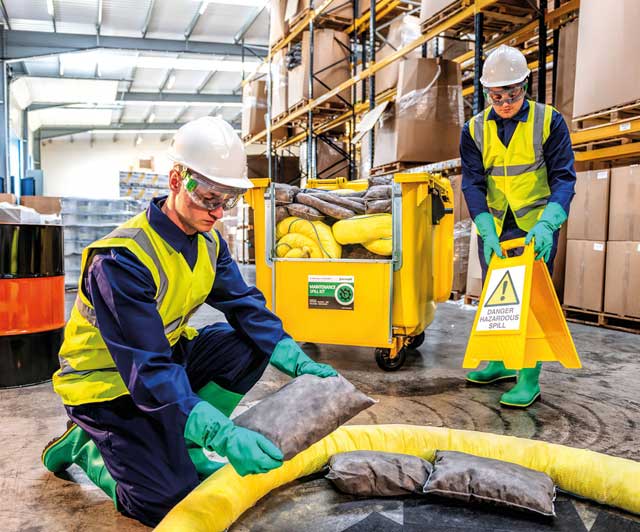
Niall Robinson, Arco product and procurement manager for workplace safety, discusses the importance of spill control and containment and how to prepare effectively.
According to the Environment Agency, in the water and waste industry alone there were 2,204 pollution incidents in 2019: that’s over six a day. Though spills can never be completely prevented, having the correct products and procedures in readiness could help reduce the negative impact caused.
Any liquid spill can cause serious health, safety and environmental problems. If not controlled, spills can lead to severe penalties, including the financial, environmental and reputational costs of the clean-up. Common examples of hazardous substances include fuels and oils, chemicals, sewage, farm manure, and slurry. However, other materials, such as food and drink products and detergents, can also cause significant risks. In fact, all liquid substances can pose risk and it doesn’t have to be a large quantity to cause a problem, meaning a variety of businesses require a proper spill containment plan.
Spill containment plans
Employers and workers must understand their own premises and carry out a proper survey and risk assessment to identify any problem areas. It is important to be aware of drainage; only clean water, such as roof drainage, should be directed to surface water drains. Contaminated water, such as sewage and trade effluent, must be directed to foul drains.
Simply storing liquids outside is not a risk-free solution and consideration needs to be given to the location, the type of container being used and any other external factors. Is the container fit for its purpose, regularly inspected and well maintained? Does it have a secondary containment option, such as a bund to contain any minor leaks or spills? Most spills occur when liquids are being moved, so the lack of a bulk delivery procedure, or a weak one, or a lack of pre delivery preparedness could leave a site exposed. Both could lead to costly consequences.
Many businesses may think that they have addressed the potential issues simply because they have spill kits and a plan in place, but this might not be enough to prevent an incident. This is often because the spill kits are placed too far away from high-risk areas, or are the wrong size or type for the spilled substance.
One of the first and most effective courses of action businesses should take is in training staff to react efficiently to an issue. A lack of training in the use of spill kits can result in the wrong type of spill kit being used, or the kit being used incorrectly. People need to know the correct procedures to follow in the event of a spill, so that it can be dealt with properly. Arco Spill Kits are designed to offer the right combination of pads, socks (minibooms), booms, sheets and hazard waste bags, to be strategically placed at risk areas to provide an immediate solution should a spill occur.
If liquid storage fails the correct action depends on the size and type of spill.
Absorbents are one of the most effective ways of cleaning up spills and are designed to be used in different ways. Some are designed to contain and recover larger scale spillages; loose absorbents such as clay granules and specialty powders are typically used for smaller spills.
Spill containment
• Socks (minibooms) are ideal for surrounding a leak or isolating an area you want to work in when there is a spill risk.
• Booms can be used on land or water to contain a range of spill types and are excellent for preventing pollution from entering the water system.
Recovery
• Pads can be used anywhere that fluids have leaked or spilt.
• Rolls provide larger areas of absorbent for placing on a work surface or flooring to provide protection.
• Pillows are excellent for absorbing spills in tight spaces. They are typically used to catch leaks under equipment or drums, but are also used to skim substances off water.
Loose absorbents
Granules are a loose absorbent and a cost-effective measure for dealing with oil, fuel, chemical, and general spills. Ideal for small areas, they are simply applied around the spill to control it. They gradually mix with the spill, absorb the excess liquid and can then be easily swept away.
Having the correct, site-specific absorbents on hand is essential to the management of any potential spillage. Alternatively, choose a spill control kit and have a quantity of each on site.
For comprehensive advice, Arco has a range of expert advice available on its website using the following link: https://campaigns.arco.co.uk/preventspills/

